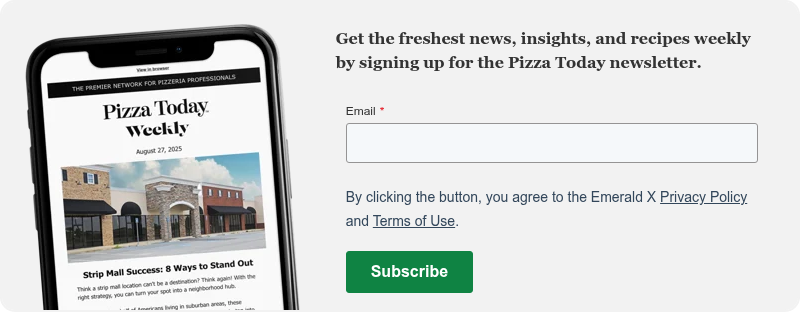For many pizzeria owners, managing inventory can feel like a constant battle against waste, rising food costs and inconsistent portioning. But what if you could transform your inventory process from a source of stress into a powerful tool for profitability?
Nick Bogacz, the founder of Caliente Pizza & Draft House in Pittsburgh, Pennsylvania, shared his honest path to mastering inventory during Pizza Expo 2025.
“There was a time where we didn’t count inventory. I’m not afraid to say that there really was,” he says. “And then, we saw the value of it.”
Today, Caliente has systems in place that identify missed delivery items, reduce waste and inform portioning for a more standardized guest experience. Pizzerias of all sizes can implement these simple, proven strategies to get costs under control and grow their businesses.
Start with Smarter Receiving Practices
Effective inventory management begins the moment a delivery truck arrives. Establishing clear, consistent habits for receiving orders is the first line of defense against waste and loss. “A lot of it is habits, creating those habits in your pizzerias – and not just for yourself, but creating them for your management team,” Bogacz explains. “That’s always the trick.”
He emphasizes the importance of immediate and proper storage to prevent frozen items from defrosting on the floor. “We’ve done things like take a video of our walk-in and send it to my rep and say, ‘Hey, this is where they go in here. Could you send this to the driver?’” By clearly labeling shelves and providing visual guides, you ensure drivers know exactly where to place cold and frozen items, preserving their quality and preventing spoilage.
Count Everything with the Driver
Counting your delivery with the driver present is non-negotiable. It holds them accountable and protects you from miss-picks and even theft.
“You’re missing a case of cheese, and you never ask about it because you didn’t count,” Bogacz warns. “The pizzeria up the street might be getting that case of cheese. … Those things happen. They absolutely happen.”
Even when it’s not malicious, drivers might be reluctant to go back for a forgotten item. Counting on the spot ensures you get everything you paid for. It’s also your opportunity to inspect deliveries for damaged goods. Don’t just accept a dented can or a torn bag. Bogacz insists, “Make sure that you’re calling up your rep and you’re getting credit for miss-picks or damaged items as well.”
Develop an Efficient Inventory Counting System
Once your receiving process is solid, the next step is implementing a regular and accurate counting system. Bogacz advocates for a practical approach that prioritizes ease and consistency.
Organize Your Count Sheet for Flow
Your inventory count sheet should be designed to match the physical layout of your pizzeria. Instead of grouping items by category (e.g., all dry goods together), organize the sheet to follow the path you walk through your restaurant.
“It flows from room to room to room, not necessarily product to product,” he says. If you have napkins in a back storeroom and also in a server alley, list napkins twice on your sheet. This “free-flowing” method makes the count faster and reduces the chance of missing items or backtracking, leading to a more accurate final number.
Consistency is King
Consistency is the most critical element of accurate inventory counting. If possible, have the same person or team count every week. “My count is going to be different than your count, and your count is going to be different than somebody else’s,” Bogacz notes. “The best counts are always if the same person is counting the same every single time.”
He recommends counting on the same day each week, typically after closing on your slowest day, like a Sunday. While you can count low-use items earlier, high-volume areas like the make line and walk-in cooler should be counted after the last order is out.
Talk About Your Numbers
Don’t keep your inventory counts a secret. Post the count sheets where your team can see them and discuss the results. When employees know you’re watching the numbers, theft naturally decreases.
“If you’re missing big-ticket items, talk about that,” Bogacz advises. “Things that get talked about in your shop, that’s where the problems stop.”
Nail Your Portion Control
Inconsistent portioning is one of the biggest drains on pizzeria profits. A little extra cheese here and a few extra pepperonis there add up quickly. Bogacz’s approach combines visual aids, training and accountability to ensure every pizza meets spec.
Use Topping Charts and Scales
Visuals are powerful training tools. Bogacz uses flipbooks on the make line that show exactly how to build every item on the menu, from wings to every gourmet pizza. These charts detail the precise amount of each ingredient.
“We have charts for everything,” he says. “It breaks down everything. From how many pieces of pepperoni go on it, how many sausage, how many mushrooms.”
While weighing every topping on every pizza can be impractical during a busy service, scales are essential for training. New employees learn what the correct portion looks and feels like by weighing it out repeatedly. This builds muscle memory and a visual reference they can rely on.
The Power of the Oven Tender
Accountability on the line is crucial. Bogacz suggests appointing an “oven tender” – often the loudest person in the kitchen – to give feedback on every pizza that comes out.
“We want somebody to say, ‘Hey, this pizza is all center-loaded.’ ‘This pizza doesn’t have enough pepperoni,’” he explains. This real-time feedback loop reinforces standards and lets the entire team know that quality and consistency are being watched. Positive reinforcement is just as important. “What we love to hear is, ‘Hey, this pizza looks right to spec.’ ‘This pizza is looking great.’”
Costing Every Ingredient
To truly understand your food cost, you must know the price of every single ingredient. Bogacz’s team works backward from the finished product to calculate the cost of each pizza down to the penny.
For example, they know a 20-ounce dough ball costs them 69 cents, 7 ounces of cheese is $1.85, and 25 slices of pepperoni are 65 cents. By adding up every component, they determined their “Godzilla” pizza costs $5.40 to make. “At a 30% food cost, we know we can sell it at $18,” he says.
This detailed costing allows you to price your menu accurately to hit your target food cost percentage. Bogacz prices his menu to achieve a 28% food cost, building in a 1.5% buffer for slight over-topping, with a final goal of 29.5%.
Turn Your Staff into Food Cost Champions
Your team is your greatest asset in the fight against high food costs. But they need to understand why it matters – and what’s in it for them. “You have to show them why it’s important to them,” Bogacz stresses.
Explain that controlling food costs allows the business to afford raises, bonuses and other perks. When you can connect inventory management directly to their wallets, you create buy-in. “Every time you throw an extra handful of cheese on that pizza, this is what it costs. You can break it down and show them.”
Incentivize Good Habits
Incentives are a powerful tool for building positive habits. Bogacz is a big believer in using giveaways to motivate his team. To encourage staff to use scales during training, he might run a 60-day contest where every time an employee is seen weighing toppings, they get a ticket for a drawing to win a $300 TV.
“What happens every 30 days? You create habits. So, if you run it for 60 days, that $300 TV just gave your store a whole new habit,” he says. The investment pays for itself through improved consistency and reduced waste.
Manage Your Distributor Relationships
Your relationship with your distributors can significantly impact your food cost. Don’t be a passive customer. Bogacz advises being proactive and vigilant.
Work with Multiple Distributors
Having at least two distributors keeps them competitive and gives you leverage. “I like to have them fight against each other,” he admits. It also provides a backup if one supplier is out of a critical item.
Watch Your Invoices
Prices can fluctuate, but you need to hold your reps accountable. Bogacz noticed that prices on his Monday delivery were different from the “live pricing” he saw when placing the order on Sunday. He also caught a distributor rounding all prices up to the nearest 50 cents.
“The more that you start talking to them about it, and the more that you can say, ‘Hey, this other distributor is doing something different,’ it gives you a little bit more to play with,” he explains. When distributors know you’re watching closely, they are less likely to let prices creep up without justification.
Your Path to Profitability
Mastering inventory isn’t a 30-day project. As Bogacz emphasizes, creating detailed recipe charts and implementing new systems takes time and dedication. But the payoff is immense. By adopting these practical, proven strategies, you can reduce waste, lower your food costs, and build a more resilient and profitable pizzeria.
Start small. Pick one area – like counting with your delivery driver – and make it a consistent habit. Then, move on to the next. By taking a systematic approach and getting your team on board, you can turn inventory management from a daunting task into one of your greatest competitive advantages.



